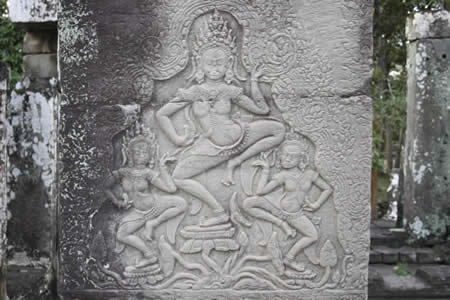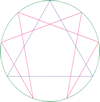
The Theoretical Structure of the Movements |
"The movements are a part, only a part, of the teaching about the possible transformation of energies in us and the sense of human life. They express the teaching in a language where each gesture, each attitude, each sequence has a specific role and meaning.”
—The Reality of Being, Jeanne de Salzmann, Shambhala 2010, page 124
What is meant by this statement?
While a great deal of practice has been developed around Gurdjieff’s Movements, little or no current theoretical understanding of the system seems to exist, even though both Gurdjieff and Jeanne De Salzmann empathetically explained that they were a science and understandable. “It is a science, a knowledge — the most fundamental of all — which can only be obtained by stages, beginning with the relation between centers in action. It has to be decoded and studied in place, in giving oneself to the practice." (ibid, p. 126)
De Salzmann described the movements as a “succession of attitudes” (ibid, p.125) and explained that "each movement expresses a whole — has its meaning as a whole." She goes on to describe some specific positions which illustrate a specific movement of energy.
But what energy? Is this energy just a sensation? This is impossible. That would be a one centered work. The energy, in fact, expresses multiple forces: sensate, emotive, and intelligent qualities. All three of these elements are present in conscious work, and any energy that is experienced — if it is real, as opposed to imaginary — must embody all three of these manifestations.
Attitudes are an emotional, or feeling state. This alone is an indicator that she was telling us that the movement does not just have a physical nature; it has a nature related to a sense of the sacred which transcends the actual physical state. She warns us against engaging in "a form that is empty of meaning," and calls us to "…an experience that we have not lived, an experience of Presence, and of Presence in movements. In fact, we have a very limited understanding of both the teaching and the language of the movements.” (ibid, p. 124.)
It would be outrageous to maintain that one can understand the movements strictly from an intellectual point of view, and that is indeed impossible. However, ignoring the question of theoretical structure and the overall, comprehensive point, purpose, and raison d'être of Gurdjieff’s movements does them no honest service either. One might argue that a work of this kind that attempts to exist independent of the ideas or cosmology that gave birth to it has forsaken both its birthright and its purpose.
The movements, in fact, represent an entire intelligible cosmological order — and in Gurdjieff’s system, cosmology and practice are not separate entities; they share an identity. It thus falls to the current generation in the work to understand the movements in a new way, not just from the practice, which has been diligent, but in terms of their meaning as a whole in relationship to the rest of the work. The chapter, after all, in which de Salzmann’s above comments appear is titled "Part of the teaching."
Only understanding the system from the theoretical, or holistic, point of view can we gain an understanding of the reason for various movements and how each one of them is structured. Much of this is discernible, but only if one understands the true function of the enneagram, and Gurdjieff’s principle elements of inner work.
Each movement represents an entire octave. The movements, taken as a whole, also represent an octave, divided into different classes of movements. The classes of movements follow the attributes or names of God, that is to say, each group of movements defines a fundamental element of inner work. Readers should refer to the essay on the elements of inner work in order to understand the relationship from a more comprehensive point of view.
It should be emphasized that each movement contains all of the major elements of inner work within it, but the relationships are constantly changing and illustrated using different arm positions which have multiple levels of meaning, relating not only to the ideas, but also to the sensation, the movement of energy between energy centers (a.k.a. chakras) prayers, and so on. So a literal interpretation, while possible, might take away from the whole entity that each movement creates, a microcosmic model of the universe, and octave within which energy develops according to the lawful relationships that are illustrated.
All of that being said, the principal structure of the movements relates to these six major categories.
1-Materiality
The principal group of movements related to materiality is the obligatories. The probably reason for the name of this group of movements — unexplained up until now — is that Materiality places man and all of the material universe under a set of physical obligations that cannot be avoided. These exist within their own octave development, leading to a series of movements with increasing degrees of complexity. Some of the folk dances incorporated into the movements canon are related to this category.
2- Desire
This group of movements relates to wish and to aim.
4-Power
This group of movements, dominated by dervish movements with powerful rhythms, is actually closely related to the group of movements regarding being, since power, rightly applied, becomes an affirmation of being through attention.
5- Being
This group of movements emphasizes efforts to develop real “I”. Movements representing "I am — I wish to be" are a major component of this group.
7-Purification
This group of movements, primarily represented by the movements associated with prayer, contains some of the most unmistakable feeling elements.
8- Wisdom
This group of movements, demanding intense attention and complex movement, represent the development of intelligence within the human organism. Because of the level of demand, the intelligence that is represented is not an automatic intelligence, but rather a free intelligence.

The suggestion is that it should be possible to classify every movement which Gurdjieff introduced according to one of these six principal categories. Within those categories, it is probably possible to assign hierarchical positions to the movements based on the levels of complexity expressed in these six elements within their own category.
Because the movements are an extremely complex structure, and no truly "decoded" record of the meanings of arm positions, interactions, and so on exists today, years of work by movements teachers would be necessary in order to fully understand this system. If that work is not undertaken, the movements will continue to remain a subjective enterprise in the realm of their intellectual meaning. Without active effort to understand this aspect of the movements, they risk undergoing a descent into shamanism and mere imitation of their original purpose.
It should be stressed again that every movement contains all of the elements necessary for an octave, because octaves don't exist independent of their elements. It is the level of association within each octave that gives us an indication of the direction the octave is taking.
One should avoid too much literalism, where possible, unless it is truly helpful in understanding the movement. There are, for example, specific positions that clearly relate directly to certain energy centers, such as the heart chakra, the abdominal chakra (the Hara), and so on. There are movements where understanding the successive relationships of these various positions gives an indication of how energy comes into relationship between the centers in the human body, and those relationships should not be ignored in favor of more subjective interpretations of their meaning.
In order to understand the relationship between energy and the various apparently "intellectual" relationships that are described above, one needs to understand that every idea, every concept, every force or influence, is in fact a form of energy.
The movements do not attempt to invoke impossibly arcane or hopelessly foreign influences; they are designed to help us become aware of the nature of energy, and the intelligence of energy. The intelligence of energy is not foreign to the human mind; the human mind is one of the component elements of the intelligence of energy.
Thus, though we work in a way that brushes up against the cloud of unknowing, and helps us to reach towards the unknowable Essence — even though we can never attain it — we are equally called to understand how that unknowable Essence expresses itself within knowable and intelligible elements. If it didn't do so, we couldn't have a Work. We could not have exchanges; we could not teach movements. So the theoretical structure is an essential part of the work, and work needs to be done to understand it, not brush it under the carpet as something that no one knows about.
This is why de Salzmann specifically referred to the movements as being only a part of the teaching. Perhaps one can't, as she maintains, understand major portions of the teachings without the movements; but equally, one can't understand the movements without the teachings.